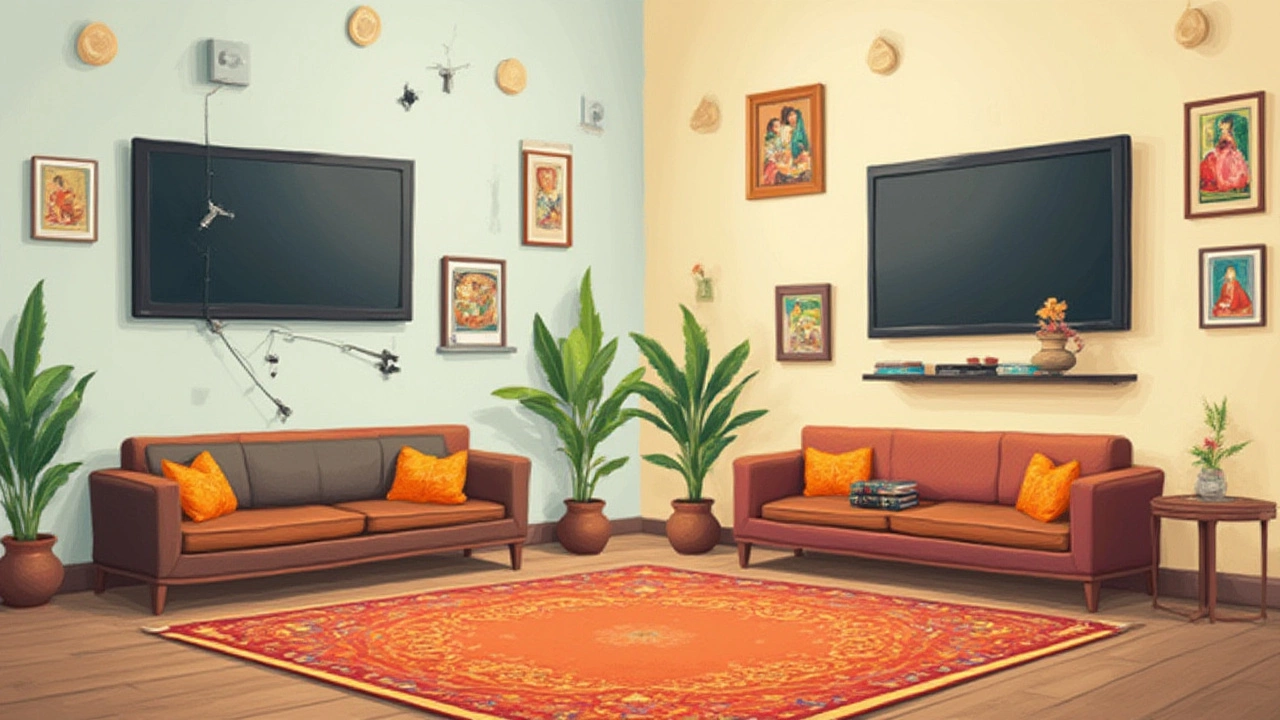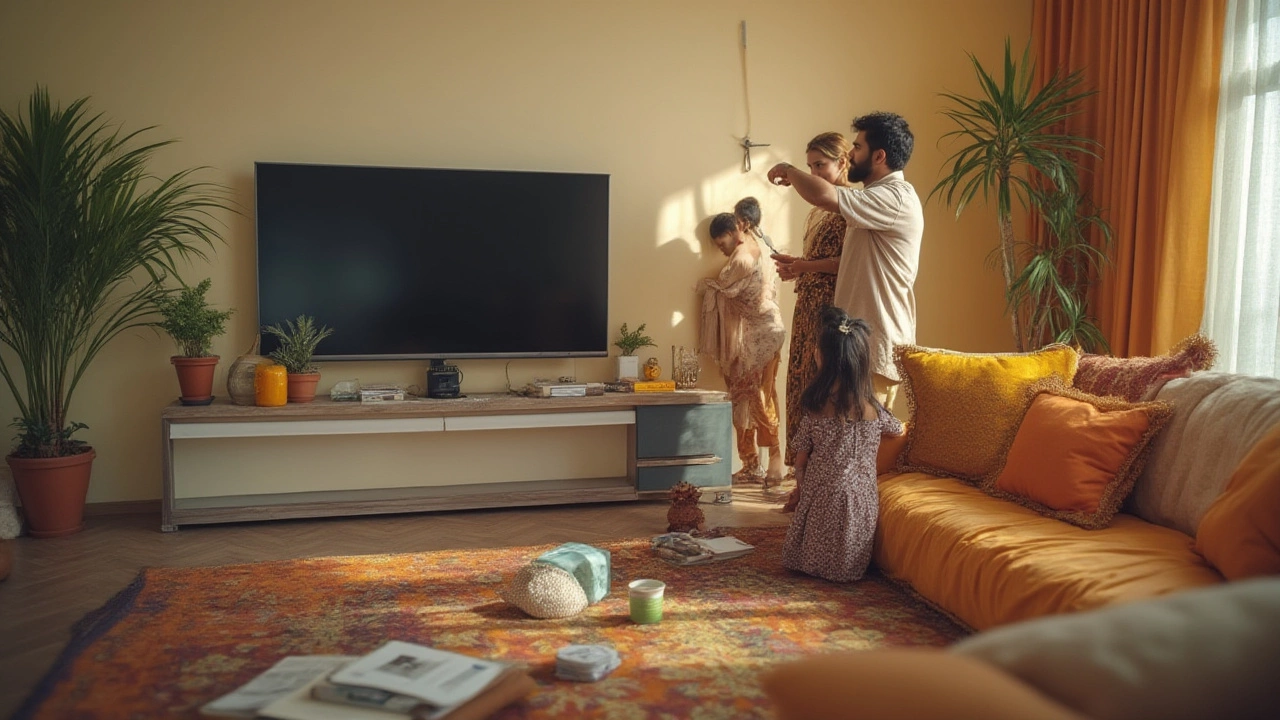Here’s a wild idea: people don’t just want their TVs hovering on walls, they want the entire TV stand to defy gravity. Search for 'Can you wall mount any TV stand?' and you’ll find all sorts of hacks—most of them a fast track to a headache—and maybe a shattered flat screen. Technology is sleek, homes are getting smaller, and furniture is expected to fit flawlessly. But can every TV stand go up on a wall like a floating shelf? The answer isn’t as simple or dreamy as Instagram reels suggest. Let’s break it down honestly—because your living room decor shouldn’t become an episode of DIY disasters.
How TV Stands Are Designed (And Why It Matters for Wall-Mounting)
Most TV stands are made for one job: sitting steadily on your floor. Open the specs for any popular budget TV stand on Amazon, and you’ll spot what they’re built from—particle board, MDF, sometimes tempered glass. These materials are sturdy when the stand’s weight is spread across the floor, but they’re no superheroes against gravity. In fact, less than 10% of TV stands on the market are sold as true "wall-mounted" units. The rest? They rely on wide, low center-of-gravity bases to stay put and keep your TV safe.
Wall-mounting upends the engineering. It changes how weight gets distributed. Suddenly, those little wood dowels and cam locks holding the stand together have to fight the entire weight of your TV stand – plus the TV, any Xbox you own, and a pile of steelcore HDMI cables. Pressure on the wrong joint and…crack. This is also why you’ll notice — if you search manufacturer installation guides — almost zero "traditional" TV stands ever mention wall mounting. It’s simply not what they’re tested (or warrantied) for.
If your mind's eye jumps to the fancy floating cabinets found in magazines or IKEA showrooms, hit pause: these units are reinforced for wall fixings, have specific hardware, and are usually made from denser, more reliable materials. A quick way to tell? Proper wall-mount cabinets have pre-drilled holes for mounting hardware on the back — not just tiny slots for ventilation or cable management.
There’s another hidden detail: a lot of TV stands are way heavier than they look. A 58-inch wood-and-glass unit can weigh upwards of 70kg (155 lbs). Even the best wall anchors can’t promise they’ll keep that safely locked into a stud if the design isn’t meant for it. If you look at most furniture store descriptions, wall mounting is rarely listed even as an option. So, next time you’re shopping, scroll all the way to the bottom of the specs. If you don’t see a wall mounting note, the safest bet is to assume it’s not meant for the wall.
What Can Happen If You Try to Wall Mount a Regular TV Stand
It’s tempting, I know. Maybe your partner’s asking for more floor space. Maybe the dog keeps bumping the stand. But screwing a regular TV stand onto your wall can create more risks than rewards. Here’s what really happens when you ignore physics and furniture design:
- Bowed or battered drywall: Most TV stands weigh between 35 and 90kg when loaded. Drywall will fail quickly if there’s no direct stud support. Even with wall anchors, the pressure can cause ugly bowing or catastrophic collapse.
- Loose joints and falling shelving: Regular TV stands are usually put together with cam bolts and screws. These can work loose over weeks, especially if you open doors or move stuff around. Eventually, shelves or the entire stand may sag or break.
- Snapped brackets or bent frames: Standard furniture brackets aren’t rated for lots of dynamic weight. Put up a non-wall unit, and the brackets could buckle under the strain, especially if someone accidentally leans on it (it happens!).
- TV stability gets dicey: Even if you do get a TV stand to stick to the wall, the TV itself might sit less stable on top. Most stands aren’t built with anti-tip lips or fixing points, so shifting the cords or dusting off that soundbar might send the whole unit sliding.
Insurance companies are getting wise to these setups, too. If a wall-mounted unit collapses and crushes your $1200 OLED TV—or worse, injures someone—there’s a good chance you’ll have trouble claiming on home insurance if you didn’t follow manufacturer instructions. Several recent lawsuits (including a small claims case in Illinois in 2023) highlight what happens when DIY mounts go south: repairs weren’t covered, and personal injury costs were left to the homeowner.
Beyond legal and financial worries, there’s the 'daily life' kind of hassle. Imagine your gaming console wobbling every time someone walks by. Or the kids yanking on a drawer that now hangs awkwardly from a failed anchor. Not fun. So if you’re eyeing a weekend wall-mount project, ask yourself: am I truly ready to drill into that risk?

Types of TV Stands You Can (And Can’t) Wall Mount
The world of TV stands is massive, but nearly every piece you see falls into just a handful of categories. Some can go up on the wall easily, others shouldn’t ever leave the floor.
| Type of TV Stand | Can Be Wall Mounted? | Notes |
|---|---|---|
| Traditional Floor Stand | No | Designed only for floor use, not engineered for wall stress. |
| Wall-Mount Cabinet/Console | Yes | Specifically built for wall mounting; comes with correct hardware. |
| Floating Shelf Units | Yes/Conditional | Must be rated for heavy TVs; look for reinforced support brackets. |
| Open Metal Frame Stands | No | Frame isn’t safe for wall fixing; legs bear the entire weight. |
| DIY-Made or Modified Stands | No (unless professionally reinforced) | Homemade modifications almost never meet safety standards. |
If you’re shopping for a floating TV look, ignore floor stands in the showroom and search for terms like “wall-mounted,” “floating media console,” or “console with wall brackets included.” These units are designed around heavy load tolerances for TVs from 40" all the way up to 80". Look up IKEA’s BESTÅ line or West Elm’s Mid-Century Wall-Mounted Media Console for examples. These have hidden back panels, extra reinforcements, and included hardware that’s actually safe for the job.
Small floating shelves that claim to handle a TV rarely mean anything bigger than 32" or 10kg. Always check the maximum load in the fine print. Otherwise, you’re flirting with a messy collapse.
If you’re wondering about customization: technically, you could reinforce a floor stand with steel angle brackets, triple-check stud placement, and bolt it to concrete—but by that point, you’re basically building a new piece of furniture from scratch. Penny smart, pound foolish, if you ask me.
What to Look for in a Safe Wall-Mount TV Stand
Safety isn’t the only thing that matters when picking your next TV stand, but it’s one that could save you a lot of money (and stress). Here’s my blueprint after too many furniture mishaps—including one where my wife Fiona caught our cat nearly knocking off our old Xbox from a teetering shelf:
- Check for dedicated wall-mounting points: The best wall mount TV stand will have metal brackets or slots on the back panel that sit flush with your wall. Flimsy holes or keyhole slots designed only for anti-tip hardware aren’t enough.
- Verify weight tolerance: The manufacturer's packaging and website should state exactly what the unit can hold (including TV and accessories). A good standard? 2x the weight of your TV, to be extra safe.
- Solid back panels matter: Stay away from pieces held together by thin MDF or open frames. A solid plywood or composite back spreads load evenly across wall studs.
- Hardware included: Any unit truly built for wall mounting comes with a full hardware kit—think heavy-duty lag bolts, wall brackets, and clear instructions for different wall types (drywall, brick, or concrete).
- Depth and stability: Check how far out the console sits from the wall once installed. Shallower is safer, and the less leverage that gravity has, the better.
- Easy cord management: Look for integrated channels or grommets for cables. Nothing ruins the floating look faster than a tangle of wires.
If you’re hiring a pro, ask them for proof of previous installs (pictures help!). If not, measure stud spacing yourself before you shop. North American homes are typically framed 16 inches on center; European homes, sometimes 24 inches. If your wall mount TV stand doesn’t have mounting points spaced for these, you’ll struggle to achieve a solid install.
And a quick reality check: sometimes, installer error is to blame. In a 2024 survey, 1 in 5 homeowners who tried wall-mounting furniture reported needing emergency repairs from failed anchors. So, if you’re tempted to trust a quick YouTube video, remember that professional installers exist for a reason.

Alternatives to Wall Mounting Your TV Stand
If you’ve made it this far, maybe you’re second-guessing your plan to bolt your current stand to the wall. Good—for your wallet, and your back! There are smarter ways to create a sleek floating look without risking disaster or violating the furniture’s warranty.
- Bolt the TV to the wall, but keep the stand floor-based: Modern wall mount kits allow TVs to hover just above a slim console. You get that minimal, "floating" vibe but skip the risk with the stand itself.
- Opt for ultra-narrow media benches: Newer furniture trends feature low-profile stands under 12 inches deep. You reclaim space and avoid mount headaches.
- Choose modular wall systems: Think IKEA or BoConcept—both offer wall-anchored storage units specifically engineered for multiple devices and heavy loads.
- Try heavy-duty anti-tip kits: If stability is all you want, inexpensive anti-tip brackets anchor the stand’s back to wall studs. They stop tipping but allow the piece to stand on the floor as designed.
- Magnetic cable organizers and under-shelf trays: Solve clutter and cord control without drilling a single hole.
Another clever hack: install adjustable shelving above an existing console. This gives you the feel of a floating system and tons of storage, with way less installation stress. And if you’re like me—always rearranging furniture for the next movie marathon—keeping the TV stand mobile can be a lifesaver.
The real lesson? There’s a reason brands put so much time (and legalese) into designing and labeling mounts. You wouldn’t hang a full fridge from your wall, right? Same goes for those big, beautiful TV stands. When in doubt, check the labels, read the manuals, or call someone who’s done it before.
Fiona says I stress too much over home projects, but she’s the one who always spots wobbles before disaster strikes. Trust your instincts, respect the weight limits, and pick the solution that fits your style wall mount TV stand dreams—without the risks.

